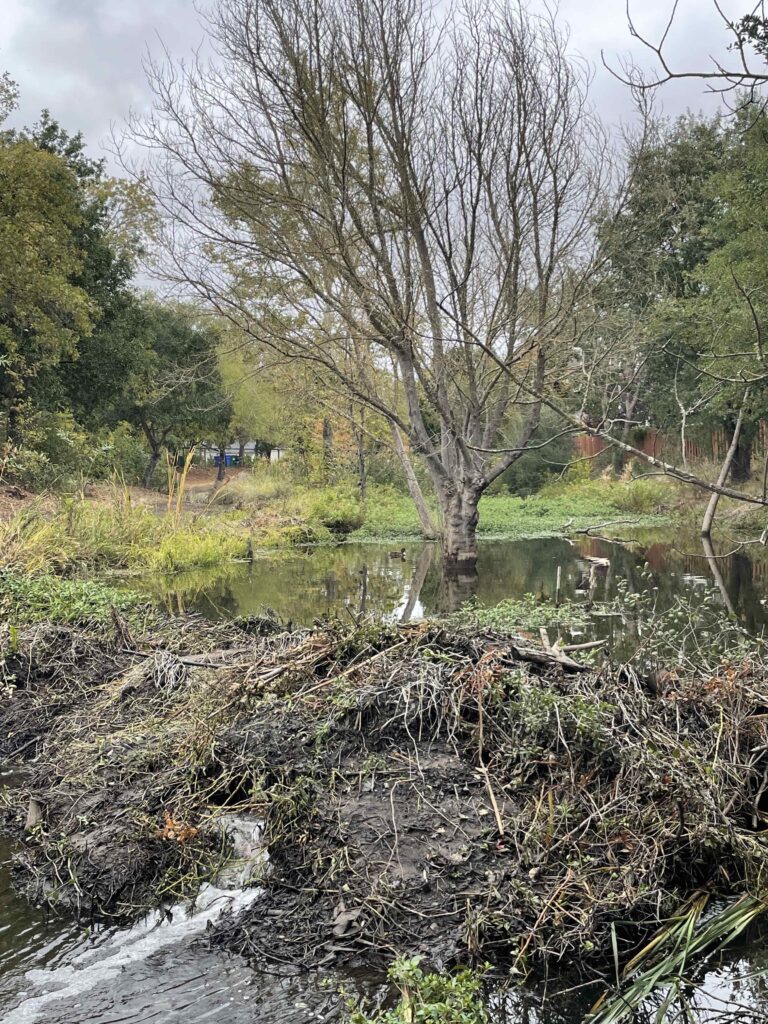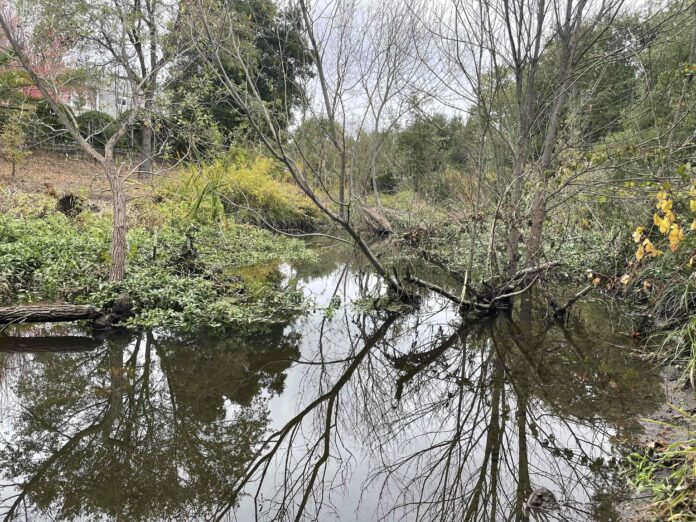On the southwest side of the City of Sonoma, a small stream named Fryer Creek cuts through a quiet neighborhood.
In late October, the creek was, like most waterways in the Bay Area, inundated with water during the “bomb cyclone” storm. However, as the rains pounded Sonoma with seven and a half inches of rain, Fryer Creek stayed fairly tame for the beginning of the storm, according to nearby residents Barabara and Larry Audiss.
“The water was really low [during the storm], even with the heavy rain, and then all at once the water was extremely high,” Larry Audiss said. “We went up and you could see where the dam had been breached.”
Larry Audiss is referring to a beaver dam close to MacArthur Street. The waters proved too strong for part of the recently built dam along this tributary of Sonoma Creek, likely pushing more water downstream.
This was not the only beaver dam in Sonoma Valley that was affected by the storm. In upper Sonoma Creek, most beaver dams were leveled by rushing waters.
However, the three beaver dams along Fryer Creek remained largely intact after the storm, perhaps due to the smaller size of the waterway. Even the dam that was breached could be rebuilt come next spring.
“[Beaver] dams in less flash flooding systems can act as a speed bump in a big torrential downpour,” Kate Lundquist, co-director of the Water Institute at the Occidental Arts & Ecology Center, said. This is what the Audisses noticed in reverse as the water rapidly rose on Fryer Creek—the sudden disappearance of a speed bump.
Advocates like those at OAEC argue that beavers play a key role in creating healthy waterways and ecosystems. The role of beavers in the recent storm is just one example of why advocates want to reintroduce—and protect—beavers throughout the state.
However, under state law, beavers are considered a “detrimental species” due in part to their dam-building, which can damage agricultural land and flood human developments. They are feared, and often killed, by landowners for this reason.
Beavers, which are native to California, are considered a keystone species due to their ability to drastically change any ecosystem they are a part of, leading to greater biodiversity. Due to their outsized impact on a landscape, their return to Sonoma Valley means many aspects of the land will change with their presence.
Often, when a beaver colony moves into an area, they begin to slow the movement of water by building their dam. This, over long periods of time, has many positive impacts on native wildlife.
“Even if all they can do is show up and build one little pipsqueak dam and create a bank burrow, they’re already jacking up the habitat diversity and providing all kinds of refuge for a bunch of different species,” Lundquist said.
Beavers use their dams to create deeper waters, making it easier for them to use their strength as swimmers to evade predators. They often build their burrows, or lodges, in the ponds to ensure a safe underwater entrance to their home. These Beaver ponds in turn create a better environment for willow trees, one of the rodent’s favored foods. It is here, just upstream from the dam, that species of fish, birds, and plants thrive.
Beaver ponds also raise the height of the groundwater, bringing cooler water up into a stream. Endangered coho salmon, which are particularly sensitive to changes in water conditions, benefit greatly from beaver dams, both as a haven for juveniles, and by keeping the water at a cooler temperature than it would be otherwise.
Not only do beavers aid in providing more habitat, their dams also filter the water, making it cleaner downstream.


In Sonoma, this could mean that if beavers were to return in significant numbers, residents would see a greater increase in biodiversity, along with a rise of the water table, which could help increase the amount of water in Sonoma Valley by keeping the water in the streams for longer. It should be noted that the town of Sonoma receives its water from the Russian River Watershed, because Sonoma Valley’s groundwater supply was drained decades ago due to farming.
“Sonoma Valley long ago outstripped its water supply, which is why there’s a big fat pipe that comes across the watershed from the Russian [River Watershed],” said Brock Dolman, co-founder and program director of OAEC.
Dolman believes we should not bank on beavers to solve our water issues in Sonoma or in California.
“I don’t think we should burden beavers with trying to save [us] in that regard,” he said.
However, they could be a great help in preventing or reducing the damage done in large storms, he pointed out.
Displaying a map of the Sonoma Valley watershed, Dolman noted that the parts of the land where beavers could thrive are also where the most porous soils are. If beavers were more present in those areas, floods might have less of a damaging impact on those areas, and, in the fire season, could create larger refuges for wildlife.
Landowners, who sometimes kill beavers, often believe they are a nuisance to the land. However, sentiments are changing. Idaho rancher Jay Wilde is advocating for the rodents after witnessing beavers create a perennial creek out of a seasonal stream on his water-parched land. In a 2019 case study in Elko, Nev., the Forest Service found that ranchers there mostly believed that “the benefits of beavers outweigh the drawbacks.”
As Dolman sees it, “The beaver glass is more than half full with benefits than half empty with problems.”
When asked if they were concerned about beavers damaging property or flooding the area surrounding Fryer Creek, Barbara Audiss said, “It doesn’t worry me, look what we’ve done.”
“We built houses, we built these,” Audiss added, pointing to the concrete path running along the creek. “We changed everything. But that’s okay. We’re learning.”
Even if one is concerned about the impacts of beavers, there are many cheap options to mitigate these issues, according to Dolman. In Fryer Creek, for instance, when beavers were first spotted in 2019, some were concerned it would create more flooding in the area, potentially drowning out the walking trails and emergency roads for vehicles.
In response, OAEC, along with beaver management consultants at Swift Water Design, helped the city of Sonoma install a pond leveling system on one of the dams in order to insure the water did not completely inundate the area.
With their presence growing in Sonoma Valley, many are happy to see the markings of beavers on these streams. And while this past storm may have breached many dams, the beavers will likely rebuild next spring, creating necessary habitat for endangered species and perhaps making local waterways flow more safely in future climate change–driven storms.











